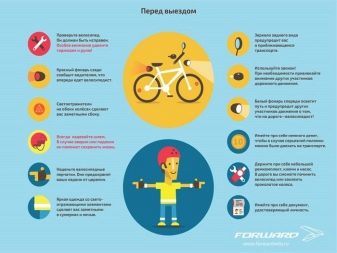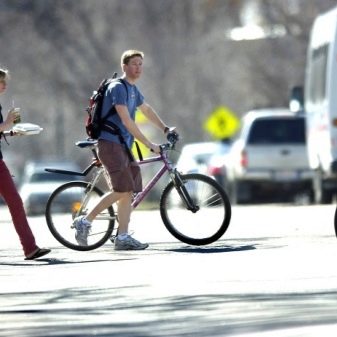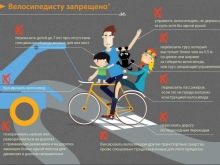As soon as the warm springtime begins, the number of bicycles and other two-wheeled vehicles on the streets increases sharply. Dozens, or even hundreds of bike owners, are pouring into a busy traffic stream.
According to experts, at least 75% of them have absolutely no idea about the rules of the road, leaving the streets of the city unprepared.
Requirements for technical equipment of cycling
What is a bicycle, even kids know, but in the SDA there is a completely accurate definition. In accordance with it, a bicycle is a type of vehicle that can have two wheels and can be set in motion due to the muscular energy of users due to pedaling, as well as handles. Some types of electric bicycles may even have an engine, the power of which with continuous load varies within 25 kW, the speed of movement of such bikes is up to 25 km / h.
It becomes obvious that a bicycle is, first of all, one of the varieties of a vehicle, therefore all the main provisions of the SDA can be fully applied to bikes.

A cyclist is the person who controls the bike. If you drive it nearby, then the owner is already becoming a pedestrian. The driver of any vehicle, including the bike, must pay special attention to the technical condition of its two-wheeled vehicle.Every time before the trip, it is necessary to assess the health of the bicycle, in particular, if the brakes are broken, as well as the coupling device or steering mechanism, any movement is strictly prohibited. In addition, there are restrictions on the movement of bicycles in the evening and at night if the rear side lights and headlights are missing or not lit.
Some bike owners are trying in every way to reduce the weight of their bike. To do this, the removal of some structural elements, including the brakes, is used - such actions are considered as a violation of existing standards, and provide for administrative punishment.
Summarizing all of the above, we can identify the following actions that a driver of a two-wheeled vehicle must perform before leaving:
- check the technical condition of the tires;
- evaluate the performance of the sound device;
- make sure all steering wheel mounts are reliable.
It is very important to monitor the performance of lighting equipment: the headlights should be white, and the rear should be bright red.


Age restrictions for cycling
People of all ages can use the bike. Moreover, each age category has its own specific features of moving on bikes. So, for users of the age group under 7 years old, traffic is exclusively allowed on pedestrian or bicycle paths, along sidewalks, as well as within the boundaries of existing pedestrian zones.
Owners of a bike in the age group of 7-14 years old are also allowed strictly on the sidewalks and other pedestrian zones, as well as on equipped bicycle paths. Driving on the roadway, as well as on the side of the road, is strictly prohibited for users under the age of 14.
A lot of dangers await little cyclists on the road. We list the most common.
- Dangerous habit. Many cyclists, especially young people, begin to move without looking around and without looking back. Meanwhile, exactly at the turn, “without looking”, cyclists are most often hit by cars.
- Desert street. On the streets with little traffic, children very often ride races, make turns and other tricks, drive out onto the roadway and even cross it without looking around.
- Unregulated intersection. When driving off a deserted street, children often cross the intersection without slowing down, especially if the road goes downhill. In this situation, they do not notice the approaching transport, which often ends in tragedy.
Citizens over 14 years old are equated with adult users, so they can move along bike paths, a specialized section of the road (if available), as well as along the roadway in situations stipulated by law.


Do I need a driver’s license?
Nowadays, a driver’s license for an electric bike and bikes is not needed, but this was not always the case. In the days of the Soviet Union, a bicycle was not only equated with ordinary transport, but also had to be registered with a license plate. The metal plate contained 4-5 digits and the validity period. It was attached to the bicycle, and a document was issued in the user's hands proving permission to drive it. Rights necessarily contained information about the type of document, as well as basic information about the owner (bike number, owner's full name, place of registration, photo, signature and seal). The document was accompanied by a set of rules for moving on city streets.
Since the bicycle is a street mode of transport, then control of this vehicle was carried out by employees of the State traffic inspectorate (GAI). Any violation of the existing rules of the road in the presence of its representatives was punishable by a fine, a warning and even deprivation of rights or number for a period established by law.In most cases, the seizure of the document resulted in a left turn on a multi-lane lane, movement on a pedestrian crossing, and also driving on a prohibitory traffic signal.
I must say that bicycle in those years was not as widespread as it is today. Most often, it was bought as entertainment for kids and teenagers, as well as the main means of transportation in villages and villages. Of course, bikes drove on the streets, but not in the same quantity as now - accordingly, the traffic police inspire more fear on the owners of cars than on cyclists. Despite this, obtaining rights was not so simple - for this it was necessary to pass a mandatory exam, which was something like modern testing. Based on the test data, rights were issued, as well as license plates for one year.
At the end of this period, it was necessary to apply for an extension of the driver’s license.


As we already mentioned, right to control the bike is not needed. However, opinions in society regarding this decision are mixed. Some believe that such a document is needed to improve the safety of all road users. Other bike owners consider the rights a Soviet remnant and believe that this method of dealing with offenders is not particularly effective. Still others even say that the “crust” from the traffic police is ineffective without a developed bicycle infrastructure. However, there are some citizens who have not even heard of rights.
Not so long ago there was information on the Internet that permissions to manage bikes would return again, but it did not find any documentary evidence. The question of when these rights will be introduced, and whether they will be introduced in principle, is still open. Nevertheless, there are requirements that establish the procedure for the movement of cyclists - they are stipulated in the SDA, and the bicycle driver must move in strict accordance with them.
I must say that in Russia there are not so many lanes for riding a bike, bike signs and special signs, in 90% of the settlements this is simply not there, and if there are any, it is in a very limited amount. Experts say that today in the Russian Federation there is an acute shortage of bike paths, and users are forced to move along the sidewalk or along the roadway. At the same time, moving along the sidewalk, the bicycle driver is already violating traffic rules to some extent, although traffic police officers look at this “through the fingers” if pedestrians are not affected.
Just imagine: if the rights reappear, then bike drivers will have to constantly move along a busy highway, and this is by no means always safe. In other words, First of all, our cyclists first need markings and signs with signs, and only then we can think about a document that will contribute to compliance with traffic rules, Do not interfere with the safe movement of the cyclist.


Where and how can I ride?
We pay special attention: the maximum permissible speed of the cyclist has set limits. So, within the city it is not allowed to exceed a speed of 60 km / h, and in parks and local territories you can drive no faster than 20 km / h. Besides, cyclists are required to comply with the requirements of established signs restricting movement. Ideally, riding a bike should be done along a specialized bike path, which is part of the main road structurally isolated from the carriageway and pedestrian sidewalks. In the context of underdeveloped bicycle infrastructure, the law provides for some exceptions.
The main one is the probability of movement on the right side of the roadway. Such maneuvers are possible:
- in the absence of a bicycle or bicycle path;
- when the strip for the bike is not formed, or moving along it is difficult;
- when the driver carries bulk cargo or trailers.
Output: if there is no fragment of the road equipped for moving on the bike, then you should go along its right side.
The second exception is roadside riding. This option is valid in the following situations:
- when there is no bicycle or bicycle path, or movement along it is difficult;
- if there is no way to move along the right edge of the road.


The third assumption is a bike ride along the sidewalk. This type of movement is likely when there is no bike lane, movement along the right edge of the road is difficult, and it is not possible to ride along the side of the road.
In addition, an adult user can ride if he accompanies a second cyclist under 7 years old or carries a child in a specially equipped seat (in a bicycle wheelchair, which is designed for use with a bike). Thus, riding in the pedestrian zone is considered an extreme option for the movement of cyclists.
We pay special attention to the fact that while riding, you must strictly follow the sequence established by law when choosing the option of moving on a bike.
There are a number of additional rules for the movement of cyclists in groups. So, when riding several athletes on the right side of the road, athletes can ride strictly in one row. The movement of a large column in 2 rows is permissible only when the maximum width of the bike is not more than 75 cm. In single-row skating, the column of athletes must be divided into small groups of 10 people, with two-row skating - into sections of 10 pairs.
For easier acceleration, it is advisable to maintain a distance between these groups at a level of 90-100 m.


When riding in large groups, special conditional gestures were adopted, which athletes send to their friends in the column:
- arm down - pit or other obstacle on the left;
- hand raised - a pit or other obstacle on the right.
The guide column is the first to give a gesture; all athletes moving after it must immediately repeat it.
When traveling by bike on a pedestrian lane and along the sidewalk It’s important not to interfere with pedestrians. In this situation, the cyclist needs to dismount and walk like a regular pedestrian.
Important: on the sidewalk of pedestrians an absolute advantage over bike drivers, this also applies to crossing intersections. In particular, a right turn should be made according to priority signs. Turning to the left side when moving along a single-lane road can be done in one step according to the shape of the trajectory. Turning to the right in other situations can be done in one of the following ways:
- cross the road like a pedestrian - simply dismount and drive the bike near you;
- in two steps —That is, driving straight, then stopping with a turn, again driving straight.


There are often disputes between bike drivers and pedestrians about who is obligated to give way to anyone. Based on the provision that the cyclist is primarily a driver of the vehicle, he will have to let pedestrians pass in the pedestrian lane, and at the crossings equipped with traffic lights, they must be allowed to cross the street and only then cross by themselves.
In accordance with the accepted standards, one of the most controversial areas for the joint movement of pedestrians and bike owners are bike paths. Some owners of two-wheeled vehicles believe that a cyclist in this area has advantages, but this is not at all the case. The fact is that pedestrians are not prohibited in any way from such special lanes, therefore, they will have to give way also on a bicycle path.
It is the responsibility of every bike driver to provide an early warning signal before each planned maneuver, even if there is no moving vehicle within sight.
Modern models of bikes are equipped with turn signals, therefore, the supply of light signals indicating a turn is carried out here in the same way as with any other vehicle. However, if the transport does not have such devices, then signals about maneuvers can be submitted by hand:
- if you want to turn right or rebuild - you need to extend your right hand or bend your left elbow;
- if you want to turn left, you should raise your left hand or bend your right;
- a raised hand indicates an ambulance to a stop.


What is forbidden to do?
Traffic rules for bike drivers set a number of restrictions. So, it is unacceptable:
- ride a bike without holding the steering gear with your hands;
- carry trailers and loads protruding more than 50 cm beyond the vehicle, or cargo that impedes safe operation;
- carry adult passengers if this does not correspond to the structural features of the vehicle;
- carry babies under 7 years old without a special child seat;
- ride adults;
- turn left or turn around on highway sections with tram tracks, as well as on tracks with more than one lane.
Besides, towing bikes by other bicycles is not allowed, in addition to towing bicycles that are structurally suitable for use with the bike.
Cyclists are not allowed on the motorway. The tragedy may end in an attempt to drive, grabbing the side of the truck. In this case, the driver of the overall vehicle does not see the cyclist who is attached behind him and does not think at all about his safety. Keep in mind - each car can move at a speed of more than 60 km / h, when driving around a pit, and also in case of emergency braking, a bicycle hitchhiker may find himself under the wheels of a freight transport.
Of course, in the current rules of the SDA there is a ban on driving a bike or an electric bike to people under the influence of drugs, as well as alcohol, as well as it is impossible to transfer control of the vehicle to a person who is drunk.



Penalty Violations
For violation of existing traffic rules in the territory of the Russian Federation, an administrative penalty is applied, which sets fines:
- for driving a bike while intoxicated - from 1 to 1,5 thousand rubles;
- in violation of traffic rules without causing damage - the amount of the fine corresponds to 800 rubles;
- in case of non-compliance with traffic rules with concomitant damage - sanctions reach 1.5 thousand rubles .;
- when creating significant interference with pedestrians and other road users - the fine will be 1 thousand rubles.


In the next video you will find more information about the rules of the road for cyclists.







